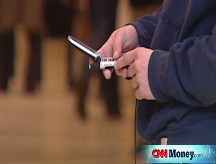One cellphone per child?
Qualcomm founder Irwin Jacobs wants smartphones in the classroom, and after school, to help make kids smarter.
NEW YORK (Fortune) -- More than two decades ago, Qualcomm co-founder Irwin Jacobs introduced the world to a new technology standard for cellphones. Now Jacobs hopes to make cell phones standard equipment in the world's classrooms.
Jacobs, who is chairman of the wireless technology company, recently spoke to Fortune about a Qualcomm-funded pilot program that put smartphones in four North Carolina high schools. "Over the years I've thought about smart phones for education," Jacobs says.
But Jacobs admits he mostly focused on using the devices to teach in the classroom; the students in the pilot program, he reports, found the phones most valuable for after-school collaboration with teachers and classmates.
"It turns out the most valuable aspect was the social networking," he says.
"They were able to interact with one another, ask questions about homework, figure out solutions."
The pilot, dubbed Project K-Nect, last year provided math students with basic HTC smartphones with limits on the people with whom the students could communicate. Using materials developed by Drexel University and Florida State University, teachers incorporated the devices into their lesson plans.
They also encouraged students to use the phones to help solve problems after school, much the way students might use computers to assist in homework.
Jacobs, who obviously has a strong personal and professional interest in promoting the use of mobile devices, maintains that cellphones are superior to computers, especially the bare-bones machines designed for classrooms in low-income and emerging markets.
"Cell phones are much more reliable and have a lot lower support costs," says Jacobs. He notes that wireless broadband connections are available om much of the U.S., making it easy for students to download rich applications and even surf the web via phones. And in markets outside the U.S., most students will only access the Net via cellphone.
Of course, not everyone agrees with Jacobs' vision of a cellphone for every student. "Texting, ringing, vibrating," Janet Bass, a spokeswoman for the American Federation of Teachers, recently told The New York Times.
"Cellphones so far haven't been an educational tool. They've been a distraction."
But the use of cell phones in education also is gaining some unexpected supporters. A recent study titled "Pockets of Potential" concluded: "While concerns about health and safety must be addressed, a new emphasis on the potential of digital media to aid learning, especially for low-income children, is overdue." The author? A research fellow at the Joan Ganz Cooney Center at Sesame Workshop.
And teachers involved in the Qualcomm-backed project are believers, too.
Suzette Kliewer, a math teacher at Southwest High School in Jacksonville, N.C., said she saw average algebra students move into honors geometry classes in part because of the leg up the smartphones gave them. She said students used the phones to record videos of their peers explaining concepts, which not only added to their problem-solving abilities, but gave them confidence presenting information, too.
"Kids are not sitting around taking pictures or texts," says Kliewer. "This project has been very beneficial to these kids."
Cell phones in the classroom won't be an easy sell, but Qualcomm's Jacobs has overcome skeptics before: When he introduced the CDMA wireless technology (short for Code division multiple access) wireless industry insiders doubted its viability, arguing that the world didn't need another digital wireless standard. (Much of the rest of the world embraced the dominant global standard, GSM.)
Still Jacobs convinced a handful of operators, including Verizon Wireless and Sprint, to adopt CDMA, and Qualcomm's intellectual property is part of so-called 3G or third generation, broadband services deployed by most all carriers, including operators that use the GSM standard. If Jacobs could get the wireless industry to accept CDMA, he should be able to convince school districts to give cell phones a try. ![]()
-
 The retail giant tops the Fortune 500 for the second year in a row. Who else made the list? More
The retail giant tops the Fortune 500 for the second year in a row. Who else made the list? More -
 This group of companies is all about social networking to connect with their customers. More
This group of companies is all about social networking to connect with their customers. More -
 The fight over the cholesterol medication is keeping a generic version from hitting the market. More
The fight over the cholesterol medication is keeping a generic version from hitting the market. More -
 Bin Laden may be dead, but the terrorist group he led doesn't need his money. More
Bin Laden may be dead, but the terrorist group he led doesn't need his money. More -
 U.S. real estate might be a mess, but in other parts of the world, home prices are jumping. More
U.S. real estate might be a mess, but in other parts of the world, home prices are jumping. More -
 Libya's output is a fraction of global production, but it's crucial to the nation's economy. More
Libya's output is a fraction of global production, but it's crucial to the nation's economy. More -
 Once rates start to rise, things could get ugly fast for our neighbors to the north. More
Once rates start to rise, things could get ugly fast for our neighbors to the north. More









